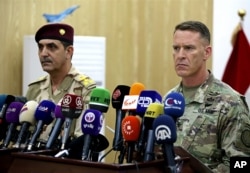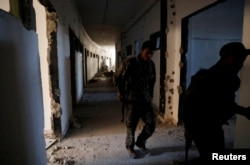When the Trump administration rolled out a new campaign in May to “annihilate” Islamic State, Secretary of Defense Jim Mattis praised tactical changes that would provide “no escape” for the terrorists.
But a convoy of thousands of Syrians — including hundreds of Islamic State (IS) fighters — permitted by U.S.-backed forces last month to leave the city once touted as the terror groups’ de facto capital, challenges that notion. Several officials told VOA it also highlights the “limitations of fighting by, with and through” local forces.
“This [convoy] is not our ideal,” U.S. Army Col. Ryan Dillon, the spokesman for the counter-Islamic State coalition, told VOA on Tuesday. “We did not want a negotiated surrender.”
According to Dillon, the convoy included about 300 potential IS fighters and 3,500 civilians who were relatives of the militants. The Syrian Democratic Forces (SDF) told the coalition the deal would prevent further civilian casualties as a result of the conflict in Raqqa.
The convoy deal was brokered by the Raqqa Civilian Council, the Syrian Democratic Forces and tribal elders in the area. While the U.S. did not take part in the deal, it was aware of the convoy agreement and carefully watched the convoy as it left the city.
Dillon told VOA he had been surprised by the large number of family members and fighters.
“In Mosul, a lot of the hard-core fighters stayed to fight to the death. We expected the same here," he said, adding about 100 more IS fighters tried to take the deal after the convoy had left, but it was too late.
Strategic questions
Back in May, Mattis called for a new approach counterterrorism approach: "From shoving ISIS out of safe locations in an attrition fight to surrounding the enemy in their strongholds so we can annihilate ISIS," he said, using an acronym for the militant group.
Some defense officials are frustrated that allowing the convoy fails to follow that strategy. But Dillon points out that the convoy deal did follow Mattis’ stated goal of “prevent(ing) the return home of escaped foreign fighters.”
Dillon said that as part of the convoy agreement, U.S.-backed fighters had gathered and processed biometric data from all potential fighters. That screening led to the discovery of four foreign fighters in the convoy, who were identified and detained by the SDF.
He said, had the U.S. seen an opportunity to strike any of the fighters without harming the civilians in the convoy, they would have done so, but the opportunity never arose.
Escaping with heavy weapons
The IS convoy recently was highlighted in an article by the BBC. The BBC claimed that a “secret deal” allowed hundreds of fighters to escape Raqqa, but the deal actually was announced in a press release on October 14.
While the deal might not have been secret, some of the details the BBC obtained from sources who took part in the convoy are worrisome. BBC’s sources report that the convoy included dozens of foreign fighters, along with tons of weapons and ammunition.
Dillon told reporters at the Pentagon he did not know why there was such a discrepancy between the U.S. data and the BBC reporting on the number of foreign fighters in the convoy.
“We are not aware of and certainly can’t corroborate the amount [of weapons] that were described in the story,” Dillon added.










